Driving the Great Ocean Road is one of Australia’s most breathtaking and iconic coastal road trips. Stretching over 240 km along the southern coast of Victoria, the Great Ocean Road weaves its way through stunning landscapes, pristine beaches, lush rainforests, and world-famous natural wonders.
It is a mesmerising expedition featuring incredible must-visit landmarks like the Twelve Apostles, Loch Ard Gorge, and the Great Otway National Park. Also comprising several charming coastal towns that offer delightful pit stops along the way, it’s an experience not to be missed if you love driving on the open road.
This article will provide you with practical tips on planning your trip, such as the best times to visit, what to see, and where to eat to ensure a smooth and unforgettable adventure.
If you intend on driving the Great Ocean Road, let this guide be your ultimate resource in providing all the information you need to know to complete it.
With that in mind, let’s get started!
Where is the Great Ocean Road?
The Great Ocean Road is located along the southern coast of Victoria in Australia.
It stretches approximately 240 km, starting from the town of Torquay, which is about 100 kilometres southwest of Melbourne and ends near the town of Allansford, approximately 275 km southwest of Melbourne.
The road winds its way along the stunning coastline, offering breathtaking views of the Southern Ocean and passing through numerous iconic natural landmarks, charming coastal towns and lush national parks.
Overall, the Great Ocean Road is one of Australia’s most famous and scenic coastal drives, attracting travellers worldwide.
Best Time to Drive the Great Ocean Road
You can drive the Great Ocean Road all year round as the bitumen is well maintained. Subsequently, when you go comes down to a matter of personal preference and availability. That said, here are some considerations for each different season.
Spring (September to November) is a beautiful time to visit the Great Ocean Road. The weather is mild, and the landscape is vibrant, with blooming wildflowers and lush greenery. It is also a great time for hiking, photography, and outdoor activities.
Similarly, Autumn (March to May) offers pleasant weather and fewer crowds. The foliage takes on stunning autumn colours, creating a picturesque backdrop for your road trip. Just like spring, it’s an excellent time for hiking and photography.
During the months of summer (December to February), it is the peak tourist season. The weather is warm, and the days are long, allowing you to make the most of your trip. However, popular attractions can get crowded, so be prepared for higher accommodation prices and book well in
advance.
The off-peak winter months (June to August) are when you’ll encounter fewer tourists and may find more affordable accommodation options. The weather can be cool, and there may be some rainy days. However, witnessing the rugged coastline under moody skies can be a unique and captivating experience.
Overall, the Great Ocean Road is a year-round destination, and the best time to visit depends on your preferences for weather, crowd levels, and seasonal scenery. Just keep in mind that weather conditions can change quickly along the coast at any time of the year, so it’s essential to be prepared for varying temperatures and pack accordingly.
What towns are along the Great Ocean Road
The Great Ocean Road passes through several picturesque coastal towns in Victoria, each offering its own unique charm and attractions. Some of the prominent towns along the route include:
Torquay: Known as the gateway to the Great Ocean Road, Torquay is a popular surf town and home to famous surf beaches such as Bells Beach. It’s also known for its surf culture and surf-related events.
Anglesea: A laid-back coastal town with beautiful beaches and the Anglesea Golf Club, where kangaroos are often spotted on the fairways.
Aireys Inlet: A tranquil town known for its iconic Split Point Lighthouse, which offers panoramic views of the coastline.
Lorne: Vibrant and bustling seaside town with stunning beaches, boutique shops, art galleries, and plenty of dining options.
Apollo Bay: A charming fishing village with a picturesque harbour, offering opportunities for fishing, boating, and whale watching.
Port Campbell: Quaint coastal town near the famous Twelve Apostles rock formations, with scenic foreshore and historic sites.
Warrnambool: Located at the western end of the Great Ocean Road, Warrnambool is a larger regional city known for its maritime history, whale-watching opportunities, and Flagstaff Hill Maritime Village.
These towns dot the Great Ocean Road and provide excellent places to stop, explore, and immerse yourself in the natural beauty and coastal culture of Victoria.
Where Does The Great Ocean Road Start and Finish?
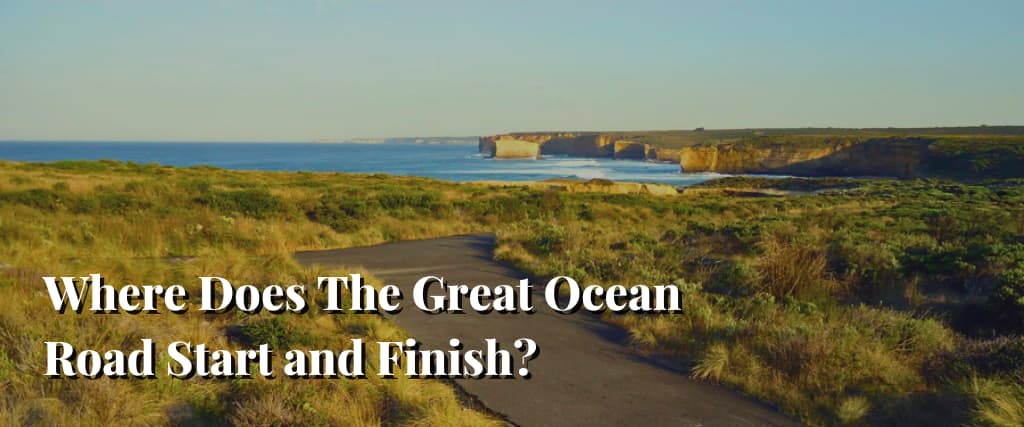
The Great Ocean Road starts in the town of Torquay and finishes near the town of Allansford, both located in the state of Victoria.
Although you can drive it from both directions, Torquay is considered the official starting point of the Great Ocean Road. The coastal town is about 100 km southwest of Melbourne and typically begins at the intersection of the Great Ocean Road and the Surf Coast Highway.
The finishing point is generally recognised as being at the town of Allansford, about 275 km southwest of Melbourne. The road ends at the intersection of the Great Ocean Road and the Princes Highway (A1) just east of town.
This scenic coastal drive covers approximately 240 km along the southern coast of Victoria, offering breathtaking views of the ocean, cliffs and iconic landmarks. The route is a popular destination for locals and in particular tourists, attracting visitors from around the world to experience the natural beauty and attractions along the Great Ocean Road.
How to get to the Great Ocean Road
The Great Ocean Road is pretty easy to get to from Melbourne and there are plenty of car hire companies operating from the city, should you not have your own vehicle.
If you prefer not to drive, you can opt for guided tours that offer convenient day trips or multi-day excursions to the Great Ocean Road. Public transport is also available, with V/Line trains or coaches departing from Melbourne to towns like Geelong, where you can easily connect to local buses for further exploration.
Whichever mode of transportation you choose, prepare to be enchanted by the stunning coastal landscapes, iconic landmarks, and captivating towns that await you on this unforgettable road trip.
Things to do on the Great Ocean Road
Driving The Great Ocean Road rewards you with a plethora of breathtaking sights and exciting activities to make your journey a memorable one.
Here are some of the top things to see and do along this iconic coastal route:
Twelve Apostles

Seeing the Twelve Apostles while driving along the Great Ocean Road is a truly awe-inspiring experience that will leave you mesmerised by nature’s grandeur.
As you approach the viewing platforms near the town of Port Campbell, the sight of these magnificent limestone stacks rising dramatically from the crashing waves of the Southern Ocean is nothing short of breathtaking. The sheer size and sculpted beauty of the Twelve Apostles make it an iconic and must-see destination for any traveller.
Whether you visit at sunrise, when the golden hues cast a magical glow on the stacks, or at sunset, when the fading light paints the cliffs in stunning colors, each moment is a feast for the senses. As you stand on the edge of the rugged coastline, you’ll feel a profound connection to the raw power of nature, leaving an indelible memory of this extraordinary encounter with one of Australia’s most iconic landmarks.
Loch Ard Gorge
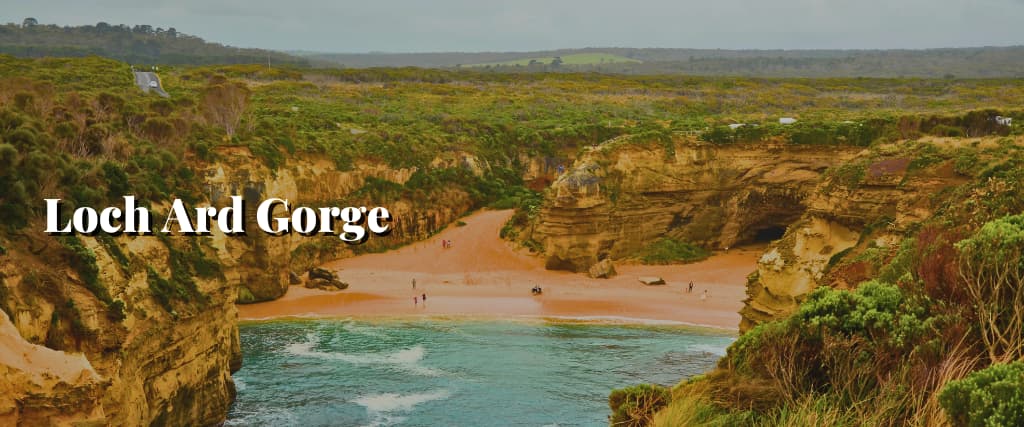
As you journey along the Great Ocean Road, a stop at Loch Ard Gorge is a captivating and poignant
moment that will transport you back in time.
This natural wonder, situated near Port Campbell, is steeped in history and beauty. As you descend to the gorge, the rugged cliffs embrace you and the pristine beach welcomes you to its sheltered cove. The story of the shipwrecked Loch Ard comes alive as you gaze at the towering limestone pillars and the razor-sharp cliffs that cradle the azure waters below.
The tranquility of the gorge contrasts with the dramatic events that unfolded here in the past. Loch Ard Gorge is a testament to the raw power of the ocean and the resilience of nature. It’s a place where history, beauty and the forces of nature converge, leaving an indelible mark on all who stand in its presence during their Great Ocean Road adventure.
London Arch (formerly London Bridge)
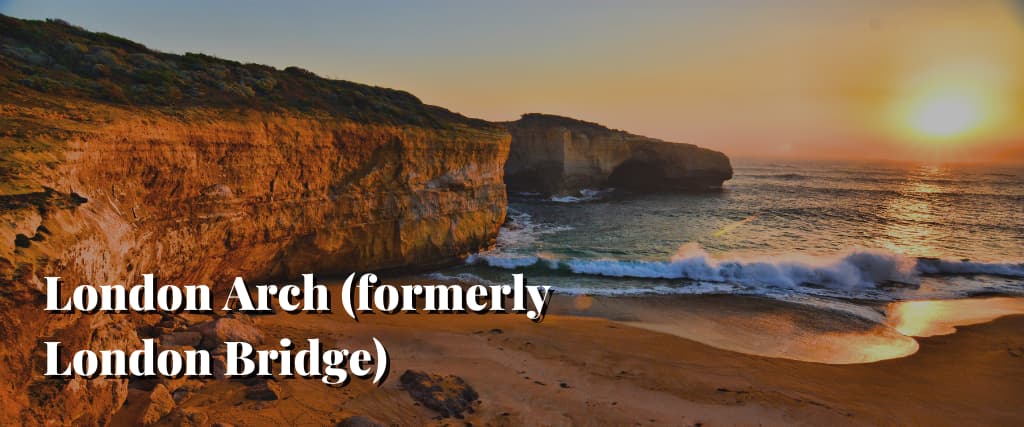
Whilst driving along the Great Ocean Road in Victoria, a visit to the London Arch provides a moment of wonder that showcases nature’s artistry.
Formerly known as London Bridge, this majestic limestone formation stands tall amidst the Southern Ocean, evoking a sense of awe and admiration. As you approach the viewing platform, the arch’s imposing presence and the crashing waves create a captivating spectacle.
The history of its transformation from a double-span natural bridge to a single arch, (hence the name change), adds intrigue to this stunning landmark. It serves as a reminder of the ever-changing forces that shape our world.
Undoubtedly, the London Arch is a photographer’s dream, offering breathtaking vistas and a glimpse into the raw beauty of Australia’s coastline. A stop here is not only a visual delight but also an opportunity to contemplate the timeless dance between sea and stone along the Great Ocean Road.
The Grotto

Another must visit destination during your drive along the scenic Great Ocean Road is The Grotto.
Nestled along the coastline, The Grotto is a captivating sinkhole connected to the sea by a narrow opening, forming a mesmerising geological marvel. As you descend the wooden staircase and step into its magical embrace, you’ll be captivated by the interplay of light and shadow, casting ethereal reflections on the water below.
The rock formations and the turquoise waters create a picturesque scene that beckons you to pause and reflect on the beauty of the natural world. The Grotto is an excellent spot for photography and a peaceful escape to immerse yourself in the serenity of the coastal landscape.
Witnessing this breathtaking sight is a testament to the Great Ocean Road’s ability to unveil hidden gems and create lasting memories of the wonders that nature has to offer.
Gibson Steps

A stop at the Gibson Steps is a must for anyone driving along the Great Ocean Road.
Located just a short distance from the iconic Twelve Apostles, this natural wonder offers a unique
perspective of the towering limestone formations. Descending the Gibson Steps carved into the cliffs, you’ll find yourself standing at the base of the colossal rock stacks, surrounded by the immensity of the Southern Ocean. The raw power of the waves crashing against the cliffs and the sense of being dwarfed by these majestic formations create a humbling and awe-inspiring experience.
The Gibson Steps provide a rare opportunity to get up close to the Twelve Apostles, immersing yourself in their grandeur and appreciating the sheer force of nature that shaped these awe-inspiring rock formations.
For many people, visiting the Gibson Steps is a highlight of the Great Ocean Road journey, allowing you to witness the raw beauty and extraordinary geological marvels that make this coastal route an unrivalled adventure.
Great Otway National Park
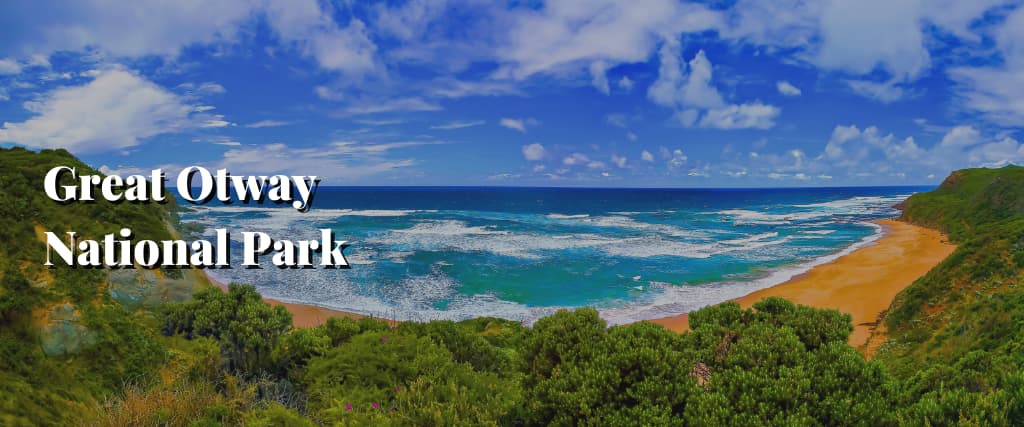
Another place you should stop off at during your drive along the Great Ocean Road is the Great Otway National Park.
Defined by its ancient forests and pristine wilderness, as you venture into the heart of this enchanting park, you’ll find yourself surrounded by towering trees, lush fern gullies and serene waterfalls. The Great Otway National Park is a paradise for nature lovers, offering diverse experiences, from tranquil rainforest walks to thrilling treetop adventures.
Explore the iconic Otway Fly Treetop Walk, where suspended walkways take you through the canopy, providing breathtaking views of the forest below. Or, venture on one of the many hiking trails that lead to hidden waterfalls and picturesque lookout points.
The park is also home to a rich array of wildlife, including koalas, kangaroos and a variety of bird species. Overall, visiting the Great Otway National Park is a chance to reconnect with nature and immerse yourself in the pristine beauty of one of Victoria’s most treasured natural wonders.
Surfing and Beaches: Torquay and Bells Beach are famous surf spots along the Great Ocean Road. If you’re a surfing enthusiast, try catching some waves here.
Cape Otway Lighthouse

The Cape Otway Lighthouse is one of the most iconic sights to see while driving the Great Ocean Road.
Perched on the edge of a dramatic cliff, the Cape Otway Lighthouse has been a beacon of hope and safety for ships navigating these treacherous waters for over 160 years. As you approach the lighthouse, the panoramic views of the Southern Ocean and the Bass Strait unfold before you, offering a breathtaking spectacle.
Explore the history of the lighthouse and the brave keepers who tended to its light, and learn about the numerous shipwrecks that occurred along this perilous coast. If you visit during the winter months, be sure to keep an eye out for migrating whales passing by, adding another layer of wonder to your experience.
Overall, The Cape Otway Lighthouse is a testament to the region’s maritime heritage and a gateway to the natural beauty and wild charm that define the Great Ocean Road journey.
Warrnambool

Warrnambool is a picturesque city along the Great Ocean Road that offers a delightful blend of coastal charm, rich history and abundant natural wonders.
This picturesque city welcomes travellers with its beautiful beaches, historic buildings, and vibrant cultural scene.
Whilst there, a visit to Flagstaff Hill Maritime Village allows you to step back in time and immerse yourself in the region’s maritime heritage. The Maritime Village recreates a 19th-century coastal port with historic ships and interactive exhibits, providing a fascinating glimpse into Warrnambool’s seafaring past.
For nature enthusiasts, a trip to Logan’s Beach during the whale-watching season (June to September) presents an opportunity to witness majestic Southern Right Whales up close as they frolic in the waters just off the coast.
With its lively cafes, art galleries, and breathtaking coastal walks, Warrnambool is a perfect stop along the Great Ocean Road, offering a blend of history, culture, and natural beauty that will leave a lasting impression on any traveller’s heart.
Scenic Lookouts
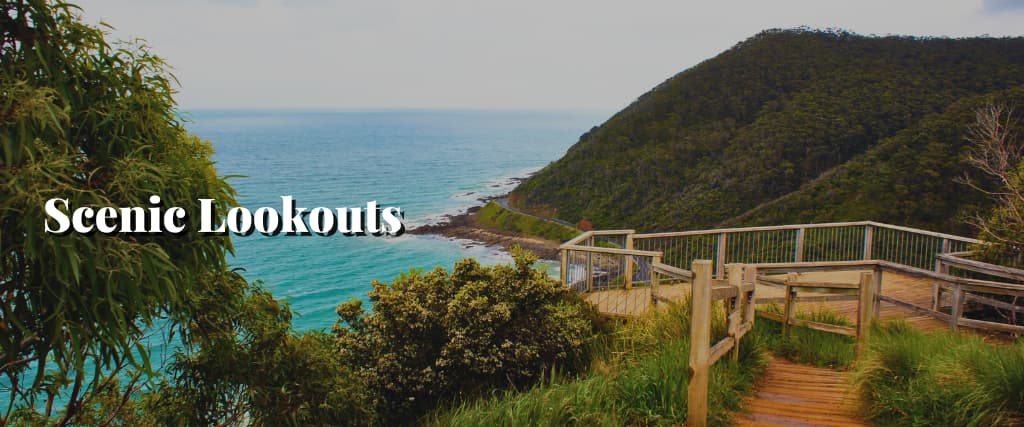
Scenic lookouts are essential to Victoria’s Great Ocean Road journey, offering travellers unparalleled vistas of the rugged coastline and iconic landmarks.
From these vantage points, you can witness nature’s grandeur at its finest. Whether it’s the panoramic views of the Twelve Apostles from multiple platforms, the breathtaking sight of Loch Ard Gorge and its towering cliffs, or the mesmerising London Arch framed against the vast Southern Ocean, each lookout is a window into the sheer beauty of the Australian coast.
Teddy’s Lookout, perched high above the forest canopy, provides sweeping views of the St. George River and the surrounding hinterland. Likewise, Mariners Lookout rewards hikers with breathtaking views of Apollo Bay and the coastline. These scenic lookouts along the Great Ocean Road are ideal for capturing postcard-worthy photographs, connecting with nature’s majesty, and experiencing the thrill of exploration that makes this coastal drive an unforgettable adventure.
Where to Eat During The Great Ocean Road Drive

Part of the Great Ocean Road driving experience involves food. Along the way, you’ll find a variety of dining options, ranging from casual cafes to fine dining restaurants, each offering a unique culinary experience.
Here are some notable places to eat during your Great Ocean Road trip:
Apollo Bay Bakery: Famous for its delectable pies and pastries, Apollo Bay Bakery is a must-stop for a quick and tasty bite. Located in the coastal town of Apollo Bay, it’s an ideal spot to grab a snack before exploring the nearby Great Otway National Park or Apollo Bay’s beautiful beaches.
La Bimba Restaurant: Situated in Apollo Bay, La Bimba is a popular choice for fine dining, focusing on
fresh, locally sourced seafood and seasonal ingredients. Enjoy modern Australian cuisine while overlooking the ocean, making it an excellent place to unwind after a day of sightseeing.
Wye Beach Hotel: Nestled in Wye River, this charming hotel boasts a restaurant with a relaxing ambience and stunning coastal views. Indulge in a hearty meal of pub-style dishes, including fresh seafood and experience the warm hospitality of this coastal gem.
Port Campbell Trading Co.: This vibrant eatery in Port Campbell serves up delicious wood-fired pizzas and gourmet burgers, perfect for a casual and satisfying meal. After visiting the Twelve Apostles, Loch Ard Gorge and other nearby attractions, stop by for a tasty and filling lunch or dinner.
Great Ocean Road Brewhouse: Located in Apollo Bay, this brewhouse offers an impressive selection of craft beers and ciders and a diverse menu featuring classic pub fare. It’s an ideal place to unwind and enjoy a cold beverage after a day of exploration.
Forage on the Foreshore: Situated in the coastal town of Port Campbell, this cosy restaurant focuses on locally sourced produce and offers a range of dishes to cater to different tastes. Enjoy a delicious meal while overlooking the scenic Port Campbell Bay.
Chris’s Beacon Point Restaurant: Positioned atop a hill with panoramic views of the coastline near Apollo Bay, this restaurant offers a unique dining experience. Serving modern Australian cuisine with an emphasis on fresh seafood, it’s a fantastic spot for a memorable dining experience.
Conclusion
Driving the Great Ocean Road is an iconic coastal route that offers an unparalleled journey through some of nature’s finest wonders. From the rugged cliffs and pristine beaches to the majestic Twelve Apostles and lush rainforests, the Great Ocean Road showcases the best of Australia’s breathtaking beauty.
Whatever your motivation for driving it, this iconic journey promises an unforgettable experience. Just remember to plan your trip wisely, considering the best times to visit, what to see and where to eat.
Whether you choose to rent a car and drive at your own pace or opt for guided tours, each mile of this incredible route is filled with captivating sights and attractions. We hope this guide has inspired you to explore, wander, and appreciate the sheer beauty of the Great Ocean Road. If it has, you really are in for a treat.
